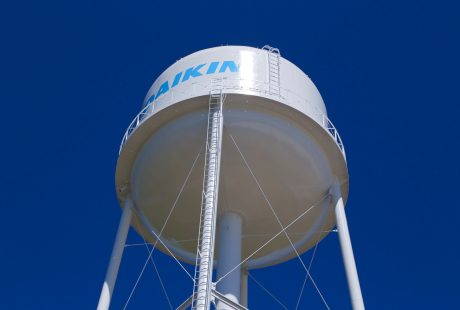By: Tom Wunderlin, Induron Sales Representative
 Are today’s “new coatings” superior to the “old coatings” and systems used to protect water storage tanks? The answer is yes for many of the coatings now on the market. The protective coatings industry is navigating complicated VOC compliance regulations. The adaptation and enforcement of these new, and more aggressive VOC regulations (link to part 1) has produced a new generation of protective coatings for potable water tanks.
Are today’s “new coatings” superior to the “old coatings” and systems used to protect water storage tanks? The answer is yes for many of the coatings now on the market. The protective coatings industry is navigating complicated VOC compliance regulations. The adaptation and enforcement of these new, and more aggressive VOC regulations (link to part 1) has produced a new generation of protective coatings for potable water tanks.
New-and-improved raw materials and technologies offer improved health and safety characteristics for applicators, faster dry times for shop and field work, enhanced ease of application methods, a larger range of acceptable application environments and improved aesthetics. Specifying the coating system with the right properties for the site-specific tank conditions is critical to achieving effective corrosion control and realizing longer service life.
These new systems include Zinc-Rich, Moisture-Cured Urethanes, DTM Acrylics, High-Solids Epoxies, Urethanes, Polysiloxanes and Fluorourethanes. New exempt solvents are being utilized to meet the ever-growing compliance regulations being enforced by various regional regulations, such as SCAQMD, CARB, LADCO, OTC Phase I, OTC Phase II, and other agencies. While some coating systems have advantages for new tank applications, others offer added value and benefits for rehabilitation, maintenance and over-coat projects of existing tanks.
All potable water storage tanks are inherently susceptible to corrosion attack. However, the application of protective coatings can effectively control the interior and exterior corrosion of water storage tanks. This results in lower operating costs, fewer repairs and an extended service life.
Potable water storage tanks face two distinct corrosive environments, so the protection method selected for use on the tank exterior is not the same for addressing corrosion inside the tank. Coatings alone are an effective protection method for the tank’s exterior. The primary function of the coating is to create a barrier to prevent chemical compounds and moisture from contacting the substrate. The coating should provide good adhesion, chemical and abrasion resistance, color retentive properties and provide UV resistance. With new limits on VOC emissions, High-Solids Polyurethanes, Fluorourethanes and Polysiloxanes have become the most widely used exterior coating finishes. The approach is different for the interior of the tank because stored water creates a vehicle for ion transfer and current flow within the structure of the steel. Coatings are used to combat this process and prevent corrosion damage.
Ceramic Epoxy Linings that are 100% solids and NSF approved are gaining momentum and becoming more commonly specified for immersion service applications for potable water tanks. These ceramic epoxies dry quicker and finishes may be applied up to 50 mils DFT in a single application direct to blasted steel, which reduces material and labor cost. Because of the varied size of the ceramic beads that compromise part of the pigment package, a liquid path to the substrate is circuitous, meaning the effective barrier coat acts even thicket than it is. These ceramic epoxies may be placed into immersion service within 72 hours, which allows the tank to be returned to service in a timely manner.
As VOC’s remain in the spotlight, some in the water industry are skeptical that alternative coatings will fall short of the corrosion protection capabilities of traditional high solvent-based products. In reality, the new chemistries and formulations demonstrate superior and enhanced protection with added benefits. Consequently, water tank owners and engineers now have economical and effective options for both new tanks and tank maintenance programs.
Contact an Induron Sales Representative to learn more about our solutions for complying to the VOC compliance regulations.




